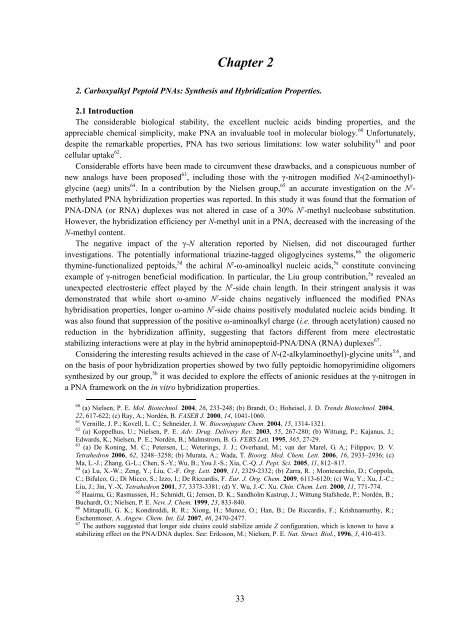Synthesis and characterization of linear and cyclic ... - EleA@UniSA
Synthesis and characterization of linear and cyclic ... - EleA@UniSA
Synthesis and characterization of linear and cyclic ... - EleA@UniSA
Create successful ePaper yourself
Turn your PDF publications into a flip-book with our unique Google optimized e-Paper software.
Chapter 2<br />
2. Carboxyalkyl Peptoid PNAs: <strong>Synthesis</strong> <strong>and</strong> Hybridization Properties.<br />
2.1 Introduction<br />
The considerable biological stability, the excellent nucleic acids binding properties, <strong>and</strong> the<br />
appreciable chemical simplicity, make PNA an invaluable tool in molecular biology. 60 Unfortunately,<br />
despite the remarkable properties, PNA has two serious limitations: low water solubility 61 <strong>and</strong> poor<br />
cellular uptake 62 .<br />
Considerable efforts have been made to circumvent these drawbacks, <strong>and</strong> a conspicuous number <strong>of</strong><br />
new analogs have been proposed 63 , including those with the γ-nitrogen modified N-(2-aminoethyl)glycine<br />
(aeg) units 64 . In a contribution by the Nielsen group, 65 an accurate investigation on the N γ -<br />
methylated PNA hybridization properties was reported. In this study it was found that the formation <strong>of</strong><br />
PNA-DNA (or RNA) duplexes was not altered in case <strong>of</strong> a 30% N γ -methyl nucleobase substitution.<br />
However, the hybridization efficiency per N-methyl unit in a PNA, decreased with the increasing <strong>of</strong> the<br />
N-methyl content.<br />
The negative impact <strong>of</strong> the γ-N alteration reported by Nielsen, did not discouraged further<br />
investigations. The potentially informational triazine-tagged oligoglycines systems, 66 the oligomeric<br />
thymine-functionalized peptoids, 5d the achiral N γ -ω-aminoalkyl nucleic acids, 5a constitute convincing<br />
example <strong>of</strong> γ-nitrogen beneficial modification. In particular, the Liu group contribution, 5a revealed an<br />
unexpected electrosteric effect played by the N γ -side chain length. In their stringent analysis it was<br />
demonstrated that while short ω-amino N γ -side chains negatively influenced the modified PNAs<br />
hybridisation properties, longer ω-amino N γ -side chains positively modulated nucleic acids binding. It<br />
was also found that suppression <strong>of</strong> the positive ω-aminoalkyl charge (i.e. through acetylation) caused no<br />
reduction in the hybridization affinity, suggesting that factors different from mere electrostatic<br />
stabilizing interactions were at play in the hybrid aminopeptoid-PNA/DNA (RNA) duplexes 67 .<br />
Considering the interesting results achieved in the case <strong>of</strong> N-(2-alkylaminoethyl)-glycine units 5,6 , <strong>and</strong><br />
on the basis <strong>of</strong> poor hybridization properties showed by two fully peptoidic homopyrimidine oligomers<br />
synthesized by our group, 5b it was decided to explore the effects <strong>of</strong> anionic residues at the γ-nitrogen in<br />
a PNA framework on the in vitro hybridization properties.<br />
60 (a) Nielsen, P. E. Mol. Biotechnol. 2004, 26, 233-248; (b) Br<strong>and</strong>t, O.; Hoheisel, J. D. Trends Biotechnol. 2004,<br />
22, 617-622; (c) Ray, A.; Nordén, B. FASEB J. 2000, 14, 1041-1060.<br />
61 Vernille, J. P.; Kovell, L. C.; Schneider, J. W. Bioconjugate Chem. 2004, 15, 1314-1321.<br />
62 (a) Koppelhus, U.; Nielsen, P. E. Adv. Drug. Delivery Rev. 2003, 55, 267-280; (b) Wittung, P.; Kajanus, J.;<br />
Edwards, K.; Nielsen, P. E.; Nordén, B.; Malmstrom, B. G. FEBS Lett. 1995, 365, 27-29.<br />
63 (a) De Koning, M. C.; Petersen, L.; Weterings, J. J.; Overh<strong>and</strong>, M.; van der Marel, G. A.; Filippov, D. V.<br />
Tetrahedron 2006, 62, 3248–3258; (b) Murata, A.; Wada, T. Bioorg. Med. Chem. Lett. 2006, 16, 2933–2936; (c)<br />
Ma, L.-J.; Zhang, G.-L.; Chen, S.-Y.; Wu, B.; You J.-S.; Xia, C.-Q. J. Pept. Sci. 2005, 11, 812–817.<br />
64 (a) Lu, X.-W.; Zeng, Y.; Liu, C.-F. Org. Lett. 2009, 11, 2329-2332; (b) Zarra, R. ; Montesarchio, D.; Coppola,<br />
C.; Bifulco, G.; Di Micco, S.; Izzo, I.; De Riccardis, F. Eur. J. Org. Chem. 2009, 6113-6120; (c) Wu, Y.; Xu, J.-C.;<br />
Liu, J.; Jin, Y.-X. Tetrahedron 2001, 57, 3373-3381; (d) Y. Wu, J.-C. Xu. Chin. Chem. Lett. 2000, 11, 771-774.<br />
65 Haaima, G.; Rasmussen, H.; Schmidt, G.; Jensen, D. K.; S<strong>and</strong>holm Kastrup, J.; Wittung Stafshede, P.; Nordén, B.;<br />
Buchardt, O.; Nielsen, P. E. New. J. Chem. 1999, 23, 833-840.<br />
66 Mittapalli, G. K.; Kondireddi, R. R.; Xiong, H.; Munoz, O.; Han, B.; De Riccardis, F.; Krishnamurthy, R.;<br />
Eschenmoser, A. Angew. Chem. Int. Ed. 2007, 46, 2470-2477.<br />
67 The authors suggested that longer side chains could stabilize amide Z configuration, which is known to have a<br />
stabilizing effect on the PNA/DNA duplex. See: Eriksson, M.; Nielsen, P. E. Nat. Struct. Biol., 1996, 3, 410-413.<br />
33

















